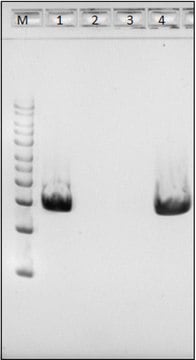All Photos(1)
About This Item
Empirical Formula (Hill Notation):
C42H63N9O8
Molecular Weight:
822.01
UNSPSC Code:
12352200
NACRES:
NA.32
Recommended Products
Assay
≥95% (HPLC)
form
lyophilized
composition
Peptide Content, ≥75%
storage condition
protect from light
storage temp.
−20°C
Amino Acid Sequence
Ac-Gln-Lys-Leu-Val-Phe-Phe-NH2
General description
Amyloid plaques characteristic of the Alzheimer brain contain fibrils composed of amyloid β aggregates. Peptides, small organic molecules and nanoparticles can be used to bind or aggregate amyloid β (Aβ). They have been used as a strategy for the development of pharmaceutical approaches or agents to treat Alzheimer′s disease (AD). Short peptides containing the sequence KLVFF have been shown to bind specifically to the homologous region in Aβ and are used to prevent full length amyloid fibril formation.
Storage Class Code
11 - Combustible Solids
WGK
WGK 3
Flash Point(F)
Not applicable
Flash Point(C)
Not applicable
Certificates of Analysis (COA)
Search for Certificates of Analysis (COA) by entering the products Lot/Batch Number. Lot and Batch Numbers can be found on a product’s label following the words ‘Lot’ or ‘Batch’.
Already Own This Product?
Find documentation for the products that you have recently purchased in the Document Library.
L O Tjernberg et al.
The Journal of biological chemistry, 272(19), 12601-12605 (1997-05-09)
We have previously shown that short peptides incorporating the sequence KLVFF can bind to the approximately 40amino acid residue Alzheimer amyloid beta-peptide (Abeta) and disrupt amyloid fibril formation (Tjernberg, L. O., Näslund, J., Lindqvist, F., Johansson, J., Karlström, A. R.
Inhibition of amyloid-? aggregation in Alzheimer's disease.
Wang Q
Current Pharmaceutical Design (2014)
Our team of scientists has experience in all areas of research including Life Science, Material Science, Chemical Synthesis, Chromatography, Analytical and many others.
Contact Technical Service






